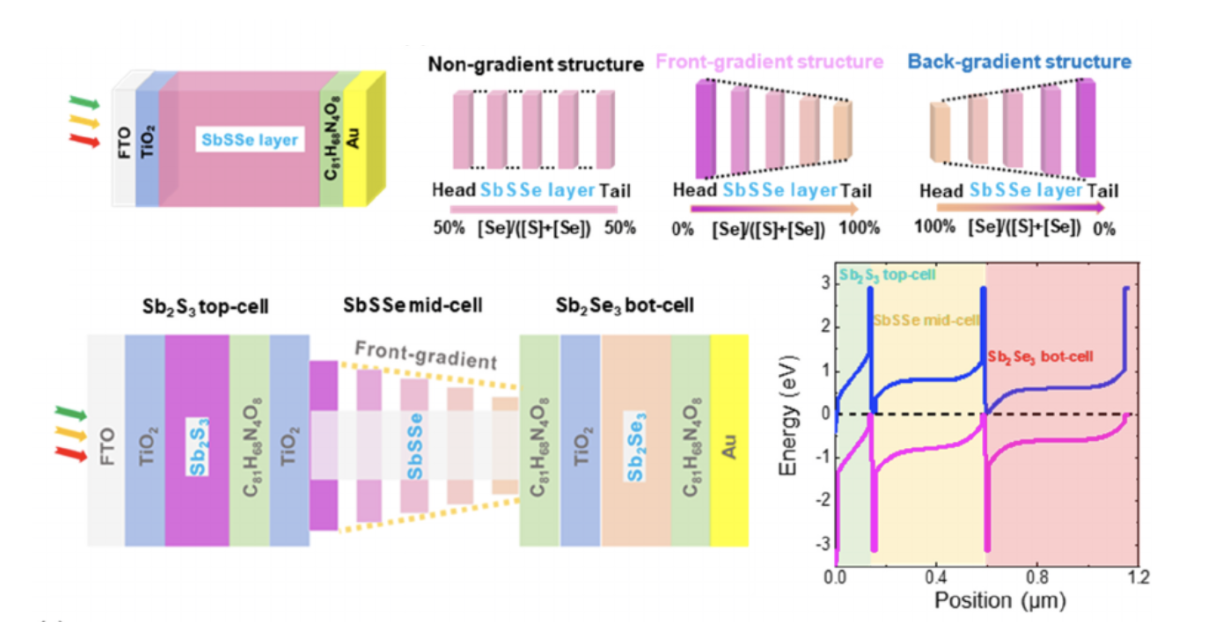V.Antimony chalcogenides emerge as a type of efficient material for solar cells. In particular, antimony sulfide-selenide (SbSSe) has attracted significant interests based on their simple preparation, excellent photoelectric performance, and tunable bandgaps. In this study, by applying energy-band engineering technologies, we achieved carrier transport balance and light absorption balance for SbSSe single- and triple-junction solar cells, respectively. First in a single junction solar cell, the photoelectric conversion efficiency (PCE) of SbSSe solar cells is improved from 13.14% to 16.16% with a front-gradient Se content structure compared to a non-gradient Se content SbSSe solar cell. This improvement is attributed to the additional electric field induced by such a gradient bandgap, promoting the carrier motion. Consequently, the balance of carrier transport is realized by adjusting the drift velocities of holes and electrons simultaneously, thereby surpassing carrier recombination and improving the device parameters of short-circuit current density (Jsc) and fill factor (FF). In a next step, an SbSSe of advanced gradient bandgap has been applied as the absorber layer of middle-cell in an antimony chalcogenide based triple-junction solar cell. Based on the high Jsc and FF advantages of SbSSe sub-cells with front-gradient Se content structure, the uniform absorption of sunlight in each sub-cell and current matching of tandem solar cells could be easily realized. Eventually, the PCE of the triple-junction solar cell exhibits an enhancement from 17.34% to 19.51%. Our results demonstrate that the application of energy-band engineering technology can effectively improve device performance, providing theoretical guidance for the refined design and nanomanufacturing development of antimony chalcogenide solar cells.

V.Antimony chalcogenides emerge as a type of efficient material for solar cells. In particular, antimony sulfide-selenide (SbSSe) has attracted significant interests based on their simple preparation, excellent photoelectric performance, and tunable bandgaps. In this study, by applying energy-band engineering technologies, we achieved carrier transport balance and light absorption balance for SbSSe single- and triple-junction solar cells, respectively. First in a single junction solar cell, the photoelectric conversion efficiency (PCE) of SbSSe solar cells is improved from 13.14% to 16.16% with a front-gradient Se content structure compared to a non-gradient Se content SbSSe solar cell. This improvement is attributed to the additional electric field induced by such a gradient bandgap, promoting the carrier motion. Consequently, the balance of carrier transport is realized by adjusting the drift velocities of holes and electrons simultaneously, thereby surpassing carrier recombination and improving the device parameters of short-circuit current density (Jsc) and fill factor (FF). In a next step, an SbSSe of advanced gradient bandgap has been applied as the absorber layer of middle-cell in an antimony chalcogenide based triple-junction solar cell. Based on the high Jsc and FF advantages of SbSSe sub-cells with front-gradient Se content structure, the uniform absorption of sunlight in each sub-cell and current matching of tandem solar cells could be easily realized. Eventually, the PCE of the triple-junction solar cell exhibits an enhancement from 17.34% to 19.51%. Our results demonstrate that the application of energy-band engineering technology can effectively improve device performance, providing theoretical guidance for the refined design and nanomanufacturing development of antimony chalcogenide solar cells.
